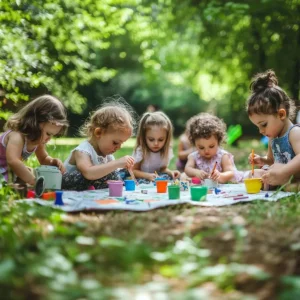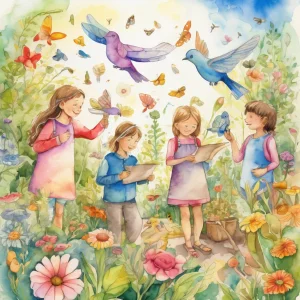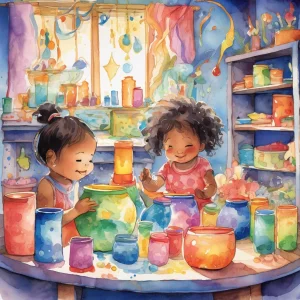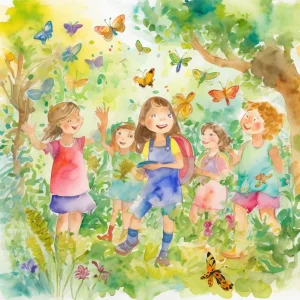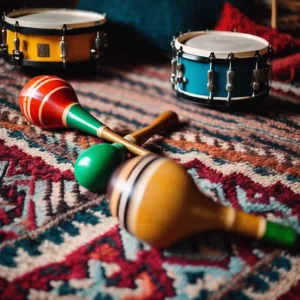Activity
Similar Activities
Seasonal Shapes Playdough Sculpting Adventure
Children’s Age: 4–6 years
Activity Duration: 15 – 20 minutes
Engage children aged 48 to 72 months in a Playdough Sculpting activity focusing on seasonal shapes to boost fine motor skills, creativity, and emotional regulation. Provide playdou…
Activity Duration: 15 – 20 minutes
Picnic Adventure: Pretend Cooking Play for Toddlers
Children’s Age: 2–3 years
Activity Duration: 10 – 30 minutes
An imaginative activity where children (ages 2-3) engage in pretend cooking during a picnic adventure.
Activity Duration: 10 – 30 minutes
Outdoor Tea Party and Fix-it Fun for Toddlers
Children’s Age: 2–4 years
Activity Duration: 10 – 25 minutes
Let's create a fun Outdoor Tea Party and Fix-it Station for kids aged 1 to 3. Set up a table and chairs, play tea set, pretend tools, household items for fixing, a picnic blanket, …
Activity Duration: 10 – 25 minutes
Enchanted Coding Adventure Storytelling with Imagination
Children’s Age: 10–12 years
Activity Duration: 45 minutes
The "Coding Adventure Storytelling" activity is tailored for children aged 10-12 to enhance empathy, play skills, language abilities, and introduce basic programming concepts in a …
Activity Duration: 45 minutes
Cultural Photo Exploration: World Wonders Journey
Children’s Age: 6–10 years
Activity Duration: 20 minutes
Embark on the "Cultural Photo Exploration" activity to boost children's play skills, cultural awareness, and academic development through an outdoor photography journey. Choose a d…
Activity Duration: 20 minutes
Enchanted Forest: Nature's Treasure Hunt Adventure
Children’s Age: 11–15 years
Activity Duration: 30 – 45 minutes
Explore the wonders of the outdoors with "Nature's Treasure Hunt," a fun and educational activity for children. This outdoor adventure boosts play skills, academic knowledge, and s…
Activity Duration: 30 – 45 minutes
Colorful Sorting Fun: Exploring Colors and Shapes
Children’s Age: 1.5–2 years
Activity Duration: 5 – 10 minutes
"Colorful Sorting Fun" is an engaging activity designed for children aged 18 to 24 months to boost their fine motor skills, cognitive abilities, and color recognition. Prepare colo…
Activity Duration: 5 – 10 minutes
Magical Storybook Adventures: Finger Paint Creations
Children’s Age: 2–2.5 years
Activity Duration: 15 minutes
Engage children aged 24 to 30 months in a creative storytelling experience to boost play skills, creativity, and language development. Set up a cozy storytelling area with paper, f…
Activity Duration: 15 minutes
Enchanted Nature Scavenger Hunt with Family and Friends
Children’s Age: 6–10 years
Activity Duration: 15 – 30 minutes
Explore the "Family and Friends Nature Scavenger Hunt," a fun-filled activity tailored for children aged 6 to 10. This engaging hunt fosters observation skills, teamwork, and envir…
Activity Duration: 15 – 30 minutes
Musical Instrument Exploration: Symphony of Sensory Play
Children’s Age: 1.5–2 years
Activity Duration: 10 minutes
Explore the Musical Instrument Exploration activity for children aged 18 to 24 months, promoting play skills, self-regulation, and communication development through a sensory-rich …
Activity Duration: 10 minutes
Starry Skies: Rocket Launch Adventure
Children’s Age: 6–10 years
Activity Duration: 25 minutes
"Rocket Launch Adventure" is an outdoor activity that engages children in a fun and interactive experience while promoting communication skills, play skills, and introducing basic …
Activity Duration: 25 minutes
Whispers of Nature: Eco-Puzzle Challenge
Children’s Age: 8–12 years
Activity Duration: 20 minutes
The "Eco-Puzzle Challenge" activity is a fun and educational way to promote empathy, play skills, and ecological awareness in children aged 8 to 12. Children work in small teams to…
Activity Duration: 20 minutes







